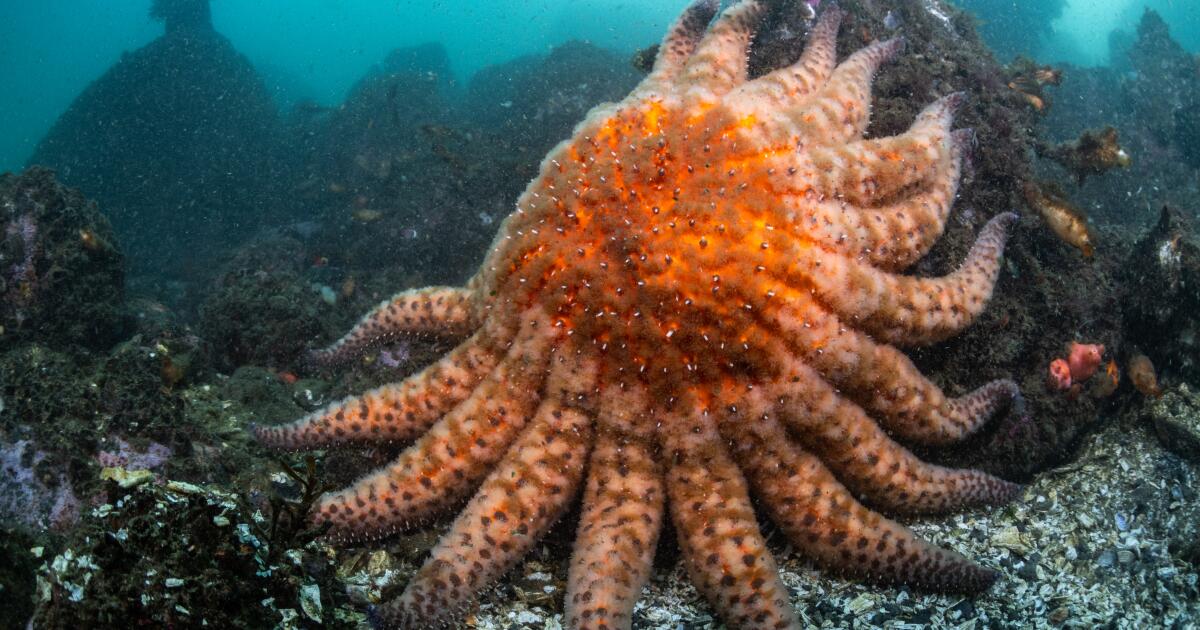Ashley Kidd signed onto the Zoom call a few minutes late, giddily explaining that 12 minutes ago there was an unexpected development in a planned spawn of critically endangered starfish.
Kidd, conservation project manager with the Sunflower Star Laboratory in the Monterey Bay area, was part of a squad set to travel to an aquarium in Alaska, where the plan was to inject the facility’s sunflower sea stars with a hormone that would induce spawning. Then, they would freeze some of the sperm of the males there and take that — plus 10 live, adult starfish and larvae — back with them to the Lower 48.
But some of the massive, velvety echinoderms began the spawning process spontaneously — three days before the group would arrive.
“The nice thing is they had six males go off, and so [with] all that sperm, because we’re going to be there on Monday, we can hit the ground running,” Kidd said.
The mission marks another step forward in a sprawling, multi-institution effort dedicated to recovering the species that scientists didn’t realize were key for maintaining healthy kelp forests until they essentially disappeared overnight.
Johnathan Casey, curator of fish and invertebrates at the Aquarium of the Pacific, views baby bull kelp growing at the aquarium’s behind-the-scenes lab.
(Allen J. Schaben / Los Angeles Times)
Sunflower sea stars — vividly colored creatures with up to 24 arms, and which can weigh as much as a small dog — once thrived along the Pacific Coast between Alaska and Baja California. Then, in 2013, a mysterious disease linked to a marine heat wave began to ravage the population. An estimated 5.75 billion sunflower sea stars perished, amounting to 94% of the global population. California lost about 99% of its Pycnopodia helianthoides to the wasting disease. Sunflower stars landed on the International Union for Conservation of Nature’s critically endangered list in 2020.
Devastation begat devastation, as the ecological dominoes began to fall.
The carnivorous sea stars munch on purple urchins and might even ward them off by making them fearful using chemical cues. Urchins devour kelp, which sequesters carbon and serves as shelter and food for a vast array of marine life. Without sea stars to balance the food web, urchin numbers have exploded. On California’s North Coast, where other urchin nemeses — like otters, spiny lobsters and sheephead — are lacking, 96% of the region’s kelp forests vanished in the decade following the sea star collapse.
“It’s kind of like the … ‘you don’t know what you have until it’s gone’ adage,” said Norah Eddy, associate director of the Nature Conservancy’s oceans program in California.

A baby sunflower sea star at the Aquarium of the Pacific in Long Beach.
(Allen J. Schaben / Los Angeles Times)
However, she added, if the starfish population could be revived, it could “turn the tide” on resuscitating kelp forests. And there are aspects of the creature’s biology that make it a good candidate for that kind of comeback. A single breeding pair of sunflower stars can potentially produce thousands of offspring — many mouths to chomp down on urchins. By comparison, bringing a single otter back to the ecosystem can take significant time and investment.
Since its collapse, California’s sunflower sea star population hasn’t meaningfully bounced back on its own. But in recent years, major strides have been made in breeding the animals in captivity with the goal of eventually releasing them in the wild.
A spawning of sea stars on Valentine’s Day of last year at the Birch Aquarium at UC San Diego’s Scripps Institution of Oceanography marked a significant milestone. It was the first successful induced spawn of the animals in California.
Kylie Lev, curator at the Steinhart Aquarium at San Francisco’s California Academy of Sciences, said it showed that researchers could facilitate breeding at a level to support reintroduction. A significant number of animals are needed because not all will make it in the wild, she said.
“We were all very happy, very surprised and shocked that this first large spawn right out the gate was able to produce so many animals,” she said. Institutions up and down the state — including the Academy, Cal Poly Humboldt, Aquarium of the Pacific in Long Beach and Monterey Bay Aquarium — took in fertilized embryos and were able to raise them into healthy stars that are still going strong.
“That kind of changed the perspective around whether or not it could be done to: it can be done, let’s make sure it’s done really thoughtfully,” she added.
Andrew Kim, a lab manager at Sunflower Star Lab, a nonprofit that leads research and conservation to recover the species, tilted his computer screen on a Zoom call to show dozens of young stars housed individually — due to rampant cannibalism — in what looked like plastic Tupperware.
“They’re all full siblings,” he said.
In fact, all the juveniles in the state are, according to Kim. That’s because only one male and one female were bred at the Birch Aquarium last year.
That makes them not exactly ideal for releasing en masse. The creatures don’t migrate so if they were thrown into a tide pool they might only have each other to mate with, Lev said. In many species, inbreeding can reduce health and fitness.
Indeed, one of the key challenges facing the scientists working to reintroduce sunflower sea stars to the California coast is the lack of genetic diversity.
Enter the Alaska SeaLife Center, an aquarium with 40 sunflower sea stars — the largest collection of the animals in the world. The researchers will bring 10 of those back to the contiguous U.S., and five will go to the Golden State. That will roughly double the six currently under human care in California.
It’s a pretty big deal, according to those involved. There were lots of regulatory hurdles that had to be cleared, involving collaboration with officials in Alaska and California. And this transfer of animals from Alaska to California should lay the groundwork for a more fluid transport of sea stars from places such as Washington and Oregon into California down the road, helping to further diversify the population there.
Researchers are galvanized by the high stakes. If the keystone species puts a check on urchins, allowing kelp forests to heal, we could recover an economic driver and a powerful tool for fighting climate change. Kelp captures carbon up to 20 times more than terrestrial forests. It’s also a home for marine animals; without kelp, many disappeared — felling fisheries that some supported.
Releasing lab-raised stars into the ocean is still at least several years away. The infrastructure and know-how for rearing the creatures needs to be beefed up. Key research and logistical questions need to be answered. A biggie is understanding more about the nature of sea star wasting disease and how to build resilience to it among the starfish. Depending on how everything shakes out, Eddy surmises stars could be reintroduced to the Pacific within three to five years.

